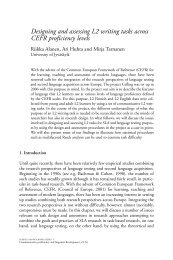BOOK OF ABSTRACTS - EUROSLA
BOOK OF ABSTRACTS - EUROSLA
BOOK OF ABSTRACTS - EUROSLA
You also want an ePaper? Increase the reach of your titles
YUMPU automatically turns print PDFs into web optimized ePapers that Google loves.
Carroll, J. B. (1973). Implications of aptitude test research and psycholinguistic<br />
theory for foreign language teaching. International Journal of Psycholinguistics,<br />
2, 5-14.<br />
Granena, G. (forthcoming). Reexamining the robustness of aptitude in near-native<br />
second language acquisition.<br />
Granena, G., & Long, M. H. (2010, October). Age of onset, length of residence,<br />
aptitude and ultimate attainment in two linguistic domains. Paper presented at<br />
the Second Language Research Forum Annual Conference, University of<br />
Maryland, College Park, MD.<br />
Meara, P. (2005). LLAMA language aptitude tests. Swansea, UK: Lognostics.<br />
Robinson, P. (2002). Individual differences in intelligence, aptitude and working<br />
memory during adult incidental second language learning: A replication and<br />
extension of Reber, Walkenfeld, and Hernstadt (1991). In P. Robinson (Ed.),<br />
Individual differences and instructed language learning (pp. 211-266).<br />
Amsterdam: Benjamins.<br />
Skehan, P. (1998). A cognitive approach to learning language. Oxford: Oxford<br />
University Press.<br />
Skehan, P. (2002). Theorizing and updating aptitude. In P. Robinson (Ed.),<br />
Individual differences and instructed language learning (pp. 69-93).<br />
Amsterdam: Benjamins.<br />
Cognitive bases of reading and writing in a second/foreign language<br />
Lea Nieminen 1 , Riikka Ullakonoja 1 , Eeva-Leena Haapakangas 1 , Ari<br />
Huhta 1 and J. Charles Alderson 2<br />
1 2<br />
University of Jyväskylä, Lancaster University<br />
Language testing researchers have recently shown interest in diagnostic<br />
testing, which is an area that intersects both language testing and second<br />
language acquisition research. Diagnostic testing, however, requires a better<br />
and more detailed understanding of language abilities than is currently the<br />
case, and this has posed challenges to testers to define their diagnostic<br />
constructs both theoretically and operationally. Tests claimed to be<br />
diagnostic are very rarely based on a theory of language learning, or a theory<br />
of diagnosis.<br />
This paper reports on the first study in a 4-year (2010-2013) research<br />
project into the diagnosis of reading and writing, which is studying two types<br />
of learners: Finnish learners of English as a foreign language in three<br />
different age groups (10 to 18-year-olds), and Russian learners of Finnish as<br />
a second language in two age groups (10 to 15-year-olds). Close to 600<br />
learners of English and about 200 learners of Finnish were studied. We will<br />
report on the findings of the first study and focus on the ability of the<br />
cognitive and psycholinguistic measures (e.g., working memory,<br />
phonological processing, ability to process non-words) to predict informants’<br />
reading and writing in L1 and L2.<br />
This first study explores the diagnostic potential of a range of cognitive<br />
and psycholinguistic measures as used for detecting L1 dyslexia. These were<br />
33



